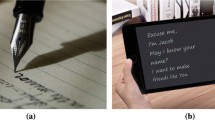Abstract
Automatic writer identification systems have several applications for police corps in order to perform criminal and terrorist identification. The objective is to identify individuals by their off-line manuscripts, using different features. Character level features are currently the best choice for performance, but this kind of biometric data needs human support to make correct character segmentation. This work presents a new system based on using Connected Component level features, which are close to character level and can be easily obtained automatically. Our experiments use Support Vector Machines using Connected Components gradient vectors to identify individuals with good results. A real-life database was used with real forensic cases in different writing conditions.
Preview
Unable to display preview. Download preview PDF.
Similar content being viewed by others
References
Hardy, H., Fagel, W.: Methodological aspects of handwriting identification. Journal of Forensic Document Examination (Fall 1995)
Huber, R.A., Headrick, A.M.: Handwriting identification: facts and fundamentals. CRC Press, Boca Raton (1999)
Jain, K., Bolle, R., Pankanti, S.: Biometrics. Personal identification in networked society. Kluwer Academic Publishers, Dordrecht (1999)
Zhang, D.D.: Automated biometrics. Technologies and systems. Kluwer Academic Publishers, Dordrecht (2000)
Srihari, S.N., et al.: Handwriting identification: research to study validity of individuality of handwriting and develop computer-assisted procedures for comparing handwriting. Tech. Rep. CEDAR-TR-01-1, Center of Excellence for Document Analysis and Recognition, University at Buffalo, State University of New York, 54 pp (February 2001)
Said, H.E.S., Peake, G.S., Tan, T.N., Baker, K.D.: Writer identification from nonuniformly skewed handwriting images. In: Proc. 9th. British Machine Vision Conference, pp. 478–487 (2000)
Kuckuck, W.: Writer recognition by spectra analysis. In: Proc. Int. Conf. In Security Through Science Engineering, West Berlin, Germany, pp. 1–3 (1980)
Srihari, S.N., Cha, S.H., Arora, H., Lee, S.: Individuality of handwriting. In: Proc. 6th. Int. Conf. on Document Analysis and Recognition (ICDAR 2001), Seattle, WA, September 2001, pp. 106–109 (2001)
Cha, S.H., Srihari, S.N.: Multiple feature integration for writer verification. In: Proc. 7th. Int. Workshop on Frontiers of Handwriting Recognition (IWFHR 2000), Amsterdam, The Netherlands, September 2000, pp. 333–342 (2000)
Zhang, B., Srihari, S.N., Lee, S.: Individuality of handwritten characters. In: Proc. 7th. Int. Conf. on Document Analysis and Recognition (ICDAR 2003), Edinburgh, Scotland (August 2003) (paper id 527)
Impedovo, S.: Fundamentals in Handwriting Recognition. Springer, Heidelberg (1994)
Gonzalez, R.C., Woods, R.E.: Digital Image Processing. Addison-Wesley, Reading (1992)
Otsu, N.: A threshold selection method from gray-scale histogram. IEEE Transactions System, Man and Cybernetics 9, 62–66 (1979)
Morris, R.N.: Forensic Handwriting Identification:fundamental concepts and principles. Academic Press, London (2000)
Vapnik, V.: The Nature of Statistical Learning Theory. Springer, New York (1995)
Burges, C., Schölkopf, B.: Improving the accuracy and speed of support vector learning machines. In: Mozer, M., Jordan, M., Petsche, T. (eds.) Advances in Neural Information Processing Systems 9, pp. 375–381. MIT Press, Cambridge (1997)
Burges, C.: A Tutorial on Support Vector Machines for Pattern Recognition. Knowledge Discovery and Data Mining 2(2), 121–167 (1998)
Author information
Authors and Affiliations
Editor information
Editors and Affiliations
Rights and permissions
Copyright information
© 2004 Springer-Verlag Berlin Heidelberg
About this paper
Cite this paper
Tapiador, M., Gómez, J., Sigüenza, J.A. (2004). Writer Identification Forensic System Based on Support Vector Machines with Connected Components. In: Orchard, B., Yang, C., Ali, M. (eds) Innovations in Applied Artificial Intelligence. IEA/AIE 2004. Lecture Notes in Computer Science(), vol 3029. Springer, Berlin, Heidelberg. https://doi.org/10.1007/978-3-540-24677-0_64
Download citation
DOI: https://doi.org/10.1007/978-3-540-24677-0_64
Publisher Name: Springer, Berlin, Heidelberg
Print ISBN: 978-3-540-22007-7
Online ISBN: 978-3-540-24677-0
eBook Packages: Springer Book Archive




